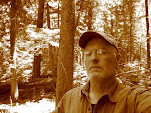Two days of wind and rain followed by a day of wind and rain and how has brought the river levels up several feet. The Quinnipiac and the Farmington are well out of their banks and into the trees and it can be assumed that all the others have followed suit. Exploring the bottom of the Scantic is put off.
So, I head to a small chain of three lakes, each separated by a short portage, which only serves to make the trip more worthwhile...the act of lifting and carrying the boat from one body of water to the next being what canoes were made for.
The first lake is housed, an older development plan that let people build all too close to the water... but even that seems to have purpose in the journey. I paddle away from town across and up the egg shaped lake to the far end and towards something farther away.
Just as I reach the top of the lake, a mature bald eagle drops down off the forested hillside and sweeps off leading the way. I grunt the portage...so short that except for my pack and one paddle, I leave my other gear in the canoe and forgo throwing it up on my shoulders, just manhandling it into the second lake, where I slip off the bank and perform the wetting of the feet ceremony. This second lake has houses also, but they are back farther from the shore, which is only half developed, and the lake has a dogleg in it with a rather fine stone gazebo at the point, which would bother me if it wasn't such a fine classic design.
The second portage is easier, being just as long, or short as the case may be, but without a hump to carry over. I guy is fishing there on his lunch break. We have a short chat before he figures out that I'm not fishing. Usually, if fishermen figure out that I am canoeing without fishing before talking with me, they treat me as if I was deranged. If we do it the other way around, I end up being one of the guys. I do like to pick their brains and get their observations since they have a different focus on it all. He did not see the bald eagle, if it came this way.

It is this third lake that is the pearl of the trip. It is S-shaped and has just two or three houses that can be seen from the water. The first is at the portage and the others are high and away from the lake...and they can and should be ignored. The lake is shallow enough that I bet one could wade across it most anyplace. It is also exactly the right depth to grow lily pads, and by June it will be blanketed in them and nearly uncanoeable. A rocky forested ridge forms much of the east shore while the rest of the boundary is low wetland or swamp. An osprey perches in a tree on the east shore until I come too close, whereupon it gets up and moves to a tree on the west shore (later, it will reverse the process). I flush a great blue heron, which moves off no farther than it feels necessary so that it continue hunting without having to watch me.

When I round the second point on the lake, the wind comes up at my back and pushes me towards the large cedar swamp that is the top of this lake. I do not like being pushed. There are a half a
dozen
Canada geese and I spot two nests on isolated hummocks that are well out in the lake. The closest one has eggs but the female has left the nest. I'm not to blame as she was gone well before I got near...I spotted her head low swimming next to her mate. I've observed geese before, I've never seen them leave a nest like that unless it has been raided. I move past as quickly as I can.
I spend less time in the swamp than I planned keeping in mind the stiff grind that the return trip could become. The high water makes it a good day to explore the narrow channels that lead into the low cedar tree swamp, but the wind...
As I return, I find the mother goose back on her nest and give her a very wide berth - she stays put. The wind changes directions. It seems that storm cells that haven't quite yet become storms are moving through the area. The wind is running around the clock...in my face, at my side, at my back, and then dying off, only to repeat a quarter hour later. I take one extra turn around the third lake, take my time staring into the forest, watch a heron catch something.
And then I work my way back to town.



























